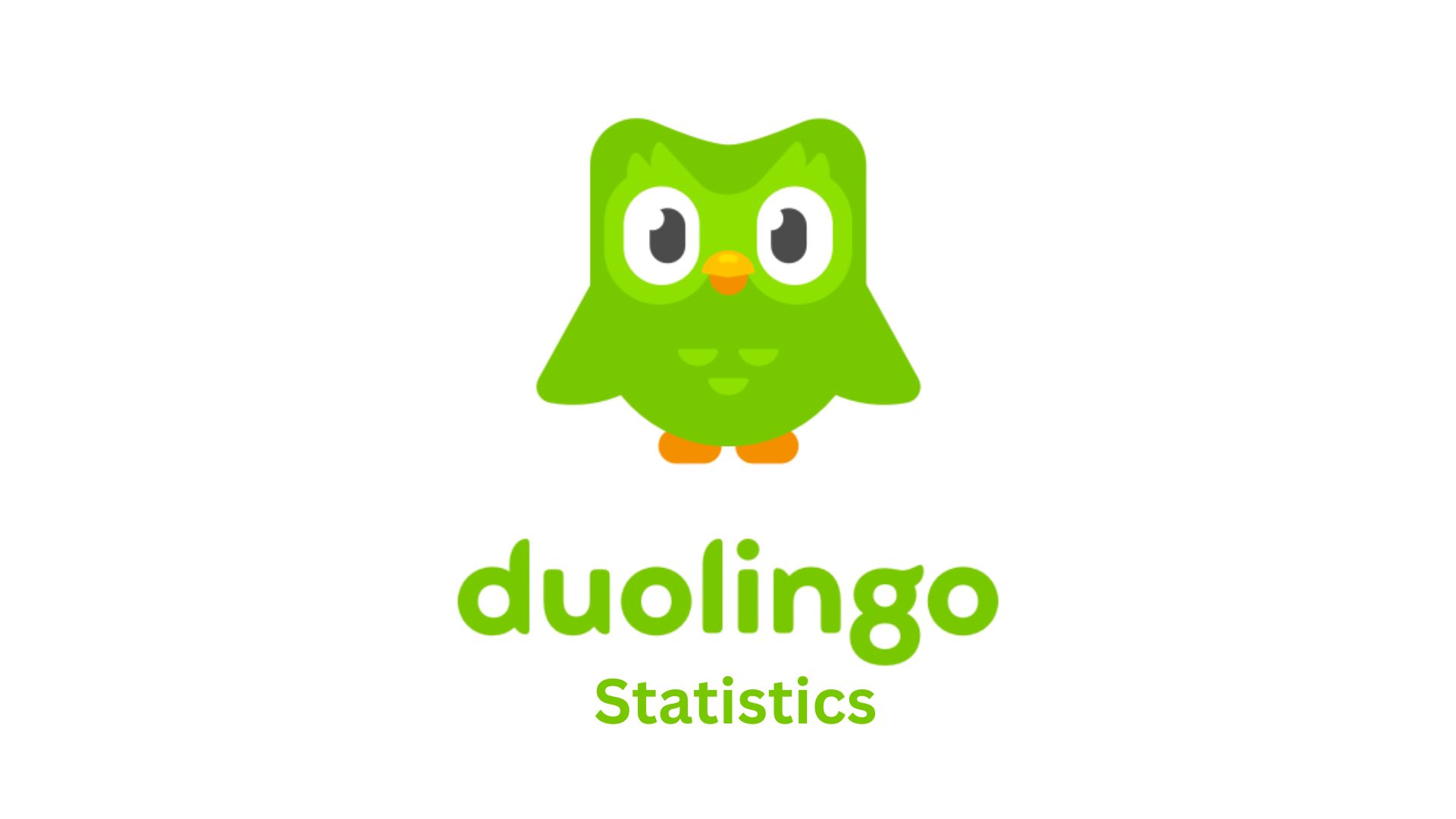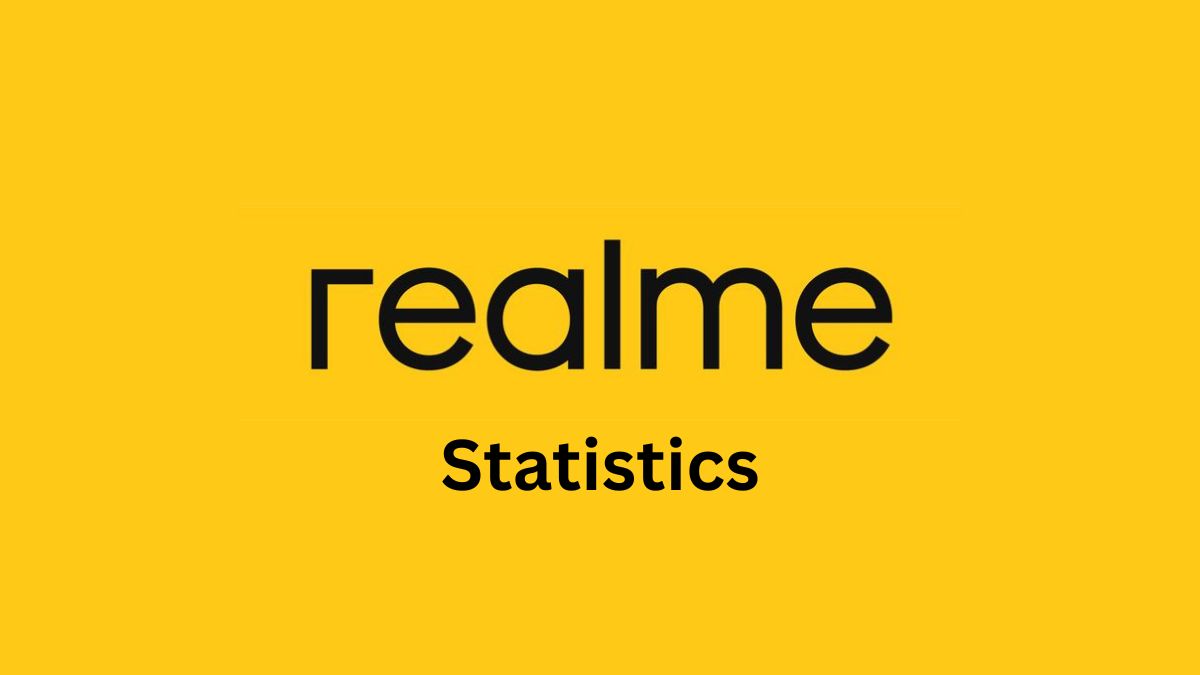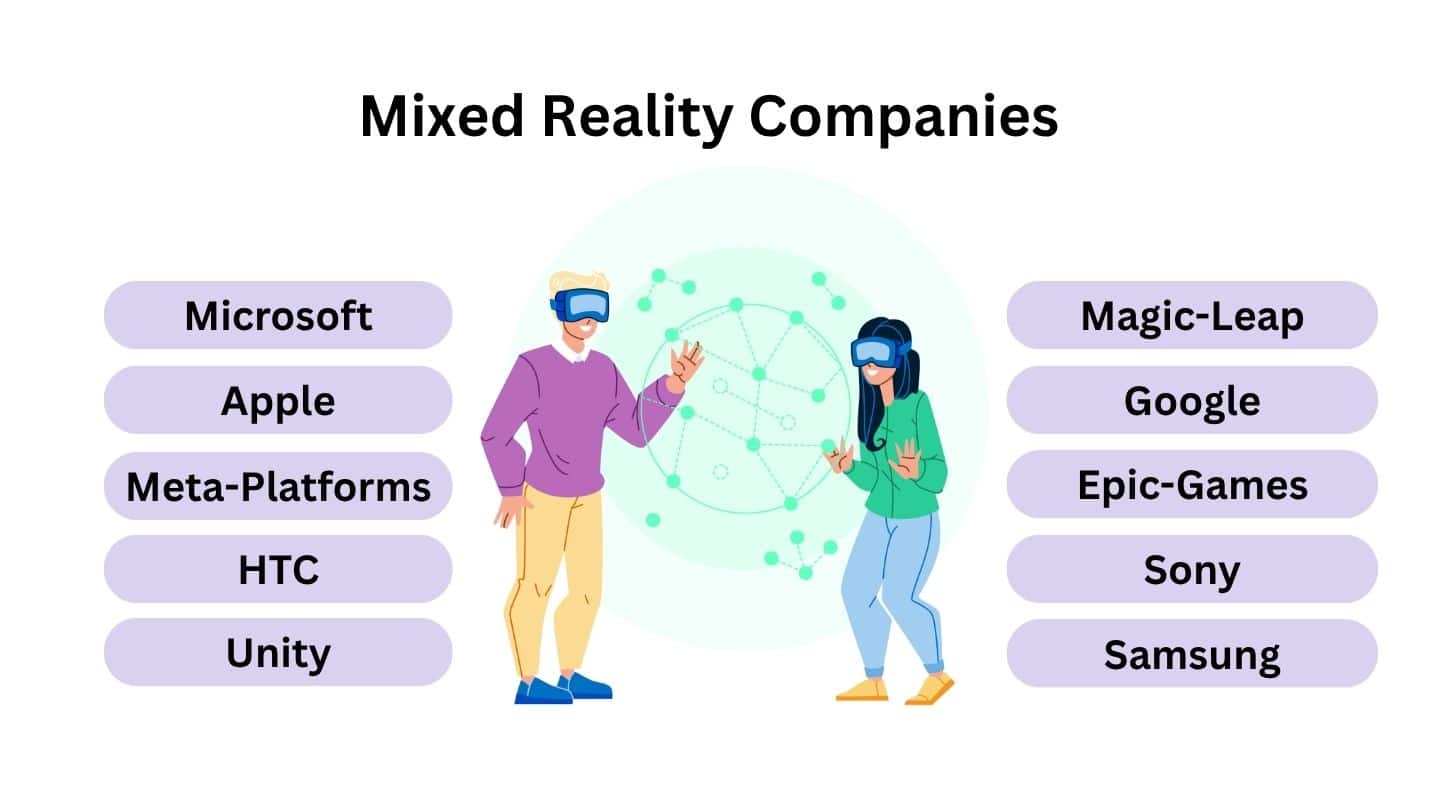YouTube vs Vimeo Statistics By Revenue, Subscribers And Country (2025)
Updated · Jun 13, 2025

Table of Contents
Introduction
YouTube vs Vimeo Statistics: In the world of online video platforms, YouTube and Vimeo hold distinct yet influential roles. As a Google property, YouTube has grown to become the world’s second-largest search engine, with billions of hours watched daily. Vimeo is oriented toward professionals and businesses seeking hosting services with supported high-quality video and no ads, with advanced collaboration and enterprise-level features.
This article will present some YouTube vs Vimeo statistics for 2025, in comparison with users, engagement, revenue, and market positioning.
Editor’s Choice
- Projected to generate US$39 billion in revenue in 2024, YouTube dwarfs Vimeo with a mere US$104.5 million in Q3 revenue for the same year under its niche SaaS model.
- As of 2024, YouTube has 100 million paid users for YouTube Music and Premium, whereas Vimeo’s paying users for self-serve plans dropped to 1.28 million in Q3 2024.
- Enterprise subscribers for Vimeo rose from 1,000 in 2021 to 3,800 as of Q3 2024, indicating its shift toward the business clientele.
- With over 10 billion downloads, YouTube is almost the most used app in the world. Vimeo’s downloads have dwindled from 7.52 million in 2021 to just 2.10 million in 2023.
- YouTube users in India: 491 million; in the U.S.: 253 million. The biggest country user base is Germany at 130,000, followed by the UK at 100,000 and Brazil at 50,000 for Vimeo.
- YouTube mobile revenue was robust in January 2024, hitting US$28 million in the U.S. and US$19 million in Japan, making money both ways.
- 21.7% of people between 25 and 34 use YouTube, followed by 18.5% of 35-44-year-olds; male vs. female use globally stands at 54.3% vs. 45.7%.
- The Vimeo user base leans towards the U.S. side, with 33% of users in the U.S. and half of the sites hosted there using Vimeo.
YouTube vs Vimeo Revenue
YouTube Revenue

(Reference: prioridata.com)
Vimeo Revenue
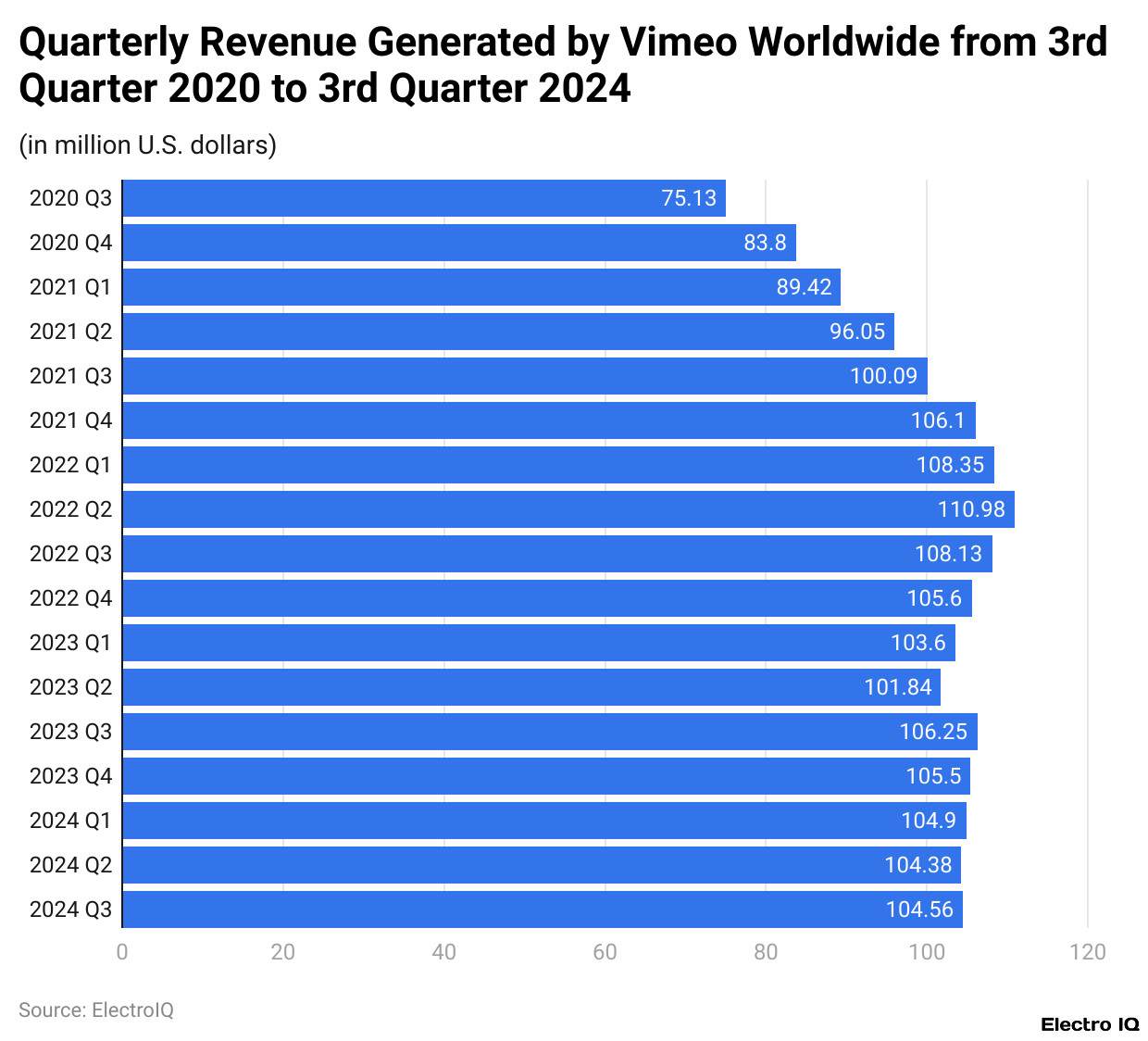
(Reference: statista.com)
- According to Porior Data and Statista, the YouTube vs Vimeo statistics state that YouTube and Vimeo revenue have contrasting paths and market positions. Since 2010, YouTube has had its glory days, single-handedly trending upwards in revenue growth by skyrocketing from US$0.8 billion in 2010 to US$3.1 billion in 2013.
- Then came US$11 billion in 2018, then a blasting US$20 billion revenue in 2020. The revenue has been making an upward linear trend ever since, logging US$29 billion in 2021 and US$31 billion in 2023, with a forecast bouncing off at US$39 billion for 2024, reflecting the dominant status of YouTube and its growing influencers in the worldwide digital and video streaming markets. Vimeo, in contrast, works on a far smaller scale.
- During the third quarter of 2024, Vimeo’s revenue was US$104.5 million, slightly down from US$106 million it generated in the same period of 2023. This slight year-on-year decline suggests a slowdown in either growth or stabilisation.
- Unlike YouTube, feed-based and massive in user scale, Vimeo is SaaS, offering premium video hosting, that is to say, enterprise tools. It was carved out of IAC and went public in May 2021, thereby switching its market positioning towards businesses and creators in need of quality and customisation as opposed to just reach.
YouTube vs Vimeo Subscribers
YouTube
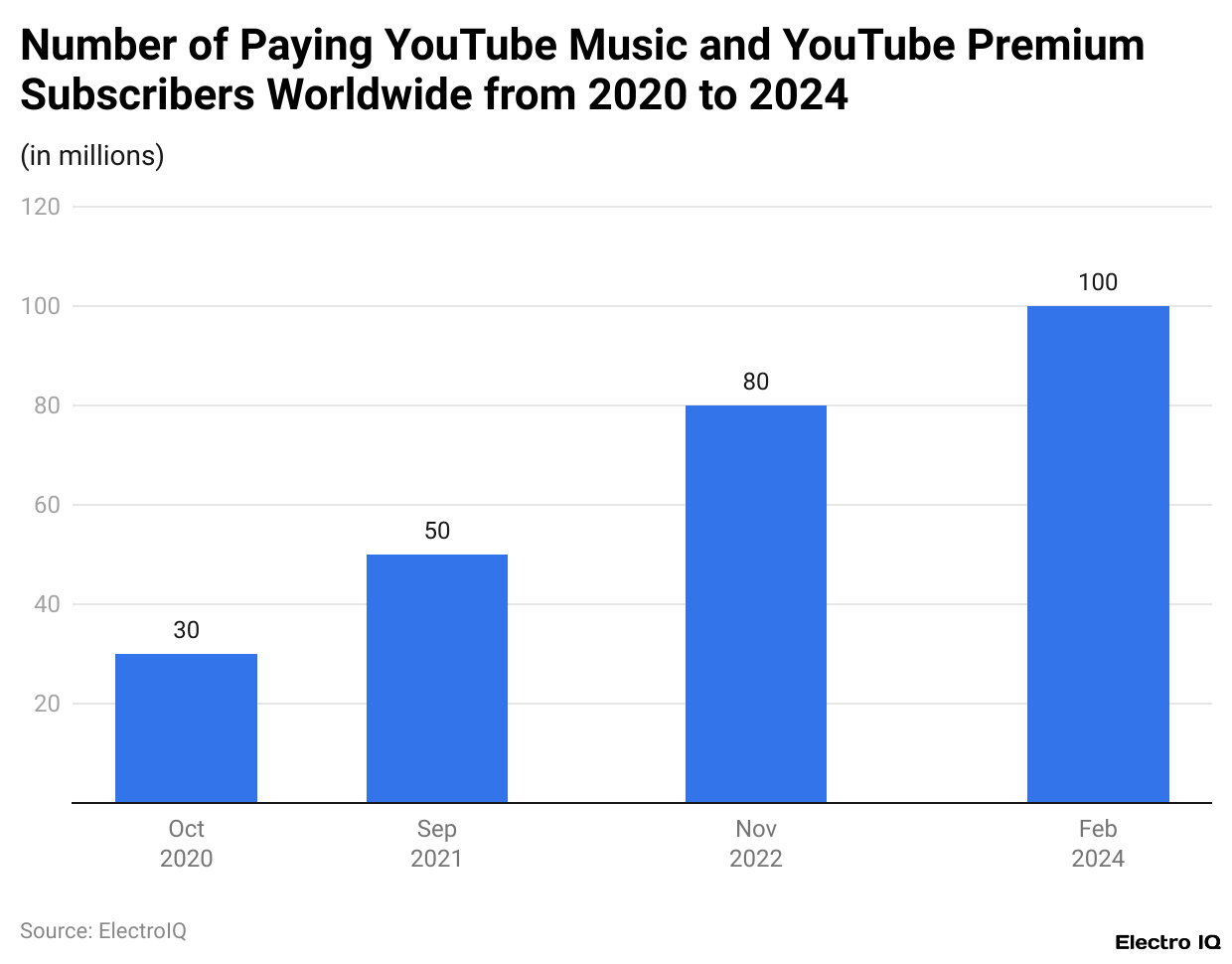
(Reference: statista.com)
Vimeo Subscribers

(Reference: statista.com)
- As of the Statista report in February 2024, YouTube vs Vimeo statistics show that YouTube claimed a paid subscriber base of the magnitude of 100 million between the Music and Premium services.
- This constitutes a huge jump from the 50 million paid users the platform had announced in September 2021.
- The doubling of subscriptions for such a duration indicates an avid and ever-growing user preference for ad-free viewing, offline access, and exclusive content.
- Complementing the subscription growth were strong advertising revenues for YouTube, with almost US$8 billion reported for Q3 2023 alone.
- These figures confirm that YouTube has successfully constructed two parallel revenue streams, one through advertising and the other through subscriptions, that continue to advance. Conversely, the trend showcases a different trajectory for paid subscribers for Vimeo.
- The “Self-Serve and Add-Ons” category, including individuals and small businesses, peaked at around 1.57 million subscriptions in Q1 2022 and slowly began declining to approximately 1.28 million by Q3 2024, indicating either saturation or loss of appeal of Vimeo’s standard offerings over time.
- Meanwhile, the “Enterprise” category of Vimeo has been experiencing a steady rise, growing from just over 1,000 subscribers in Q1 2021 to nearly 3,800 by Q3 2024. This impressive growth manifests that Vimeo has been moving toward serving enterprise clients with video solutions that are on the higher end and tools that include AI-powered services and enterprise-grade security.
- The “Other” subscriber category for Vimeo has been on a steady downward trend from approximately 175,000 in Q1 2021 to around 53,500 by Q3 2024, denoting either decreasing importance or shifting to other plans.
- YouTube has its ears to the ground, enlarging its user base in both ad-supported and premium facets, whereas Vimeo contemplates a shrinking pie of individual subscriptions in favour of enhancing enterprise adoption, thus giving the first signs of a strategic tilt toward business clientele.
YouTube vs Vimeo App Downloads
YouTube

(Source: affmaven.com)
Vimeo
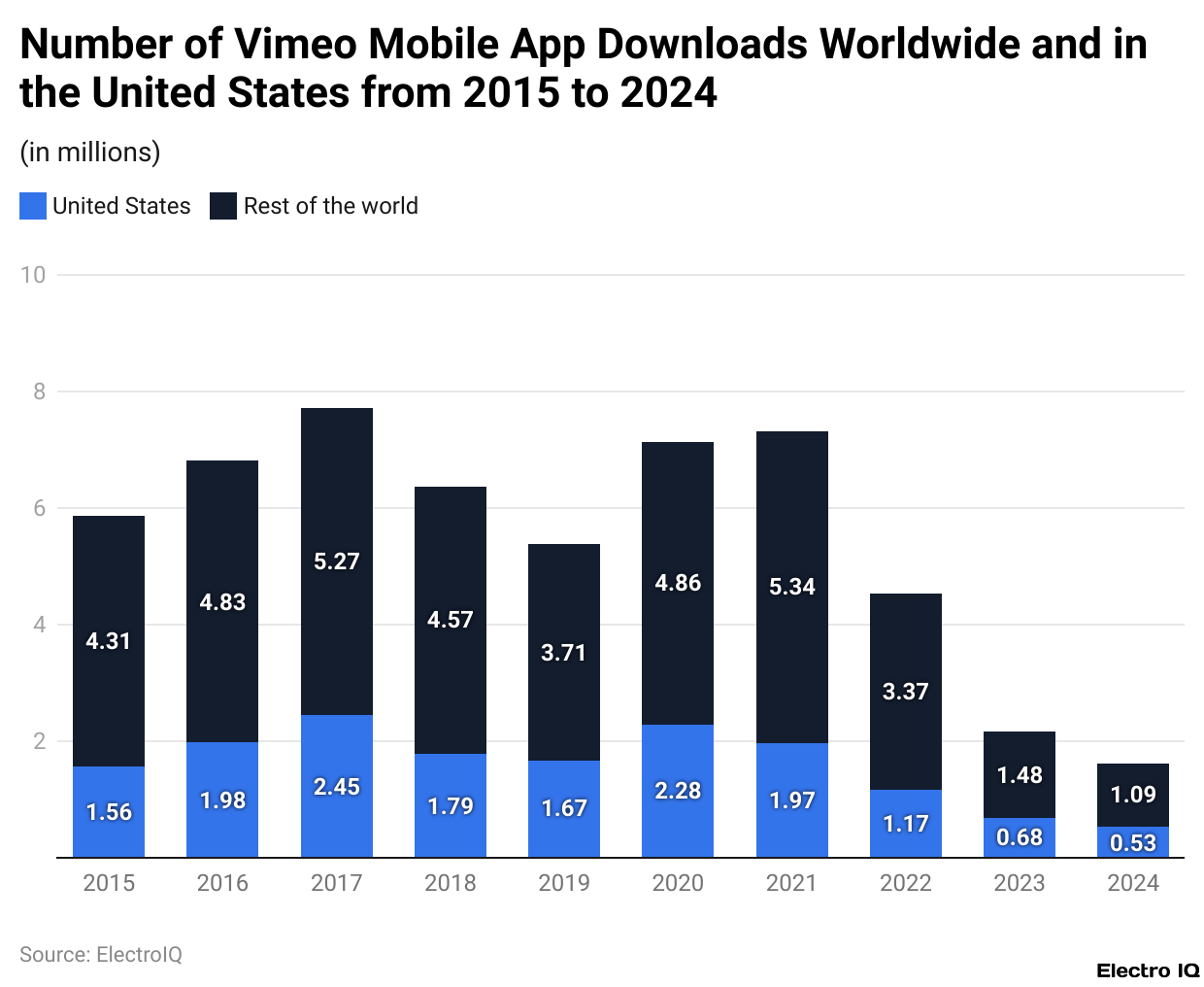
(Reference: statista.com)
- According to Affmaven and Statista, YouTube vs Vimeo statistics reveal that undoubtedly, the YouTube mobile app has maintained its global level of endorsement and went beyond 10 billion downloads on Google Play as early as 2021 and remains in the top 10 of the world’s most downloaded apps.
- Just for iOS, it claims over 866 million monthly active users, with active daily engagement all around. Since 2022, YouTube has always maintained above 10 billion in download numbers, showing uninterrupted interest by users on an upward growth trajectory on both Android and iOS platforms.
- Contrarily, the last few years have witnessed a gradual decline in the number of downloads for the Vimeo mobile app.
- In 2023, approximately 2.10 million global downloads were recorded, with the United States accounting for about 670 thousand of them. That, however, is a drop from 2022, when global downloads stood at about 4.42 million, with the U.S. accounting for about 1.1 million.
- The platform’s glory days came in 2021, with global downloads amounting to 7.52 million and 1.94 million from the U.S. After reaching that peak, it has since followed a gradual downtrend with time, probably due to increased competition and a dwindling user base.
- While YouTube figures portray a globally dominant platform with mass appeal, Vimeo stats seem to point to the shrinking of a much smaller, highly segmented audience.
- Despite the downtrend, Vimeo continues to maintain a niche of professional users at a fairly stable level who value high-quality, ad-free video hosting and enterprise-grade tools, for which YouTube does not really specialise.
YouTube vs Vimeo Users By Country
YouTube
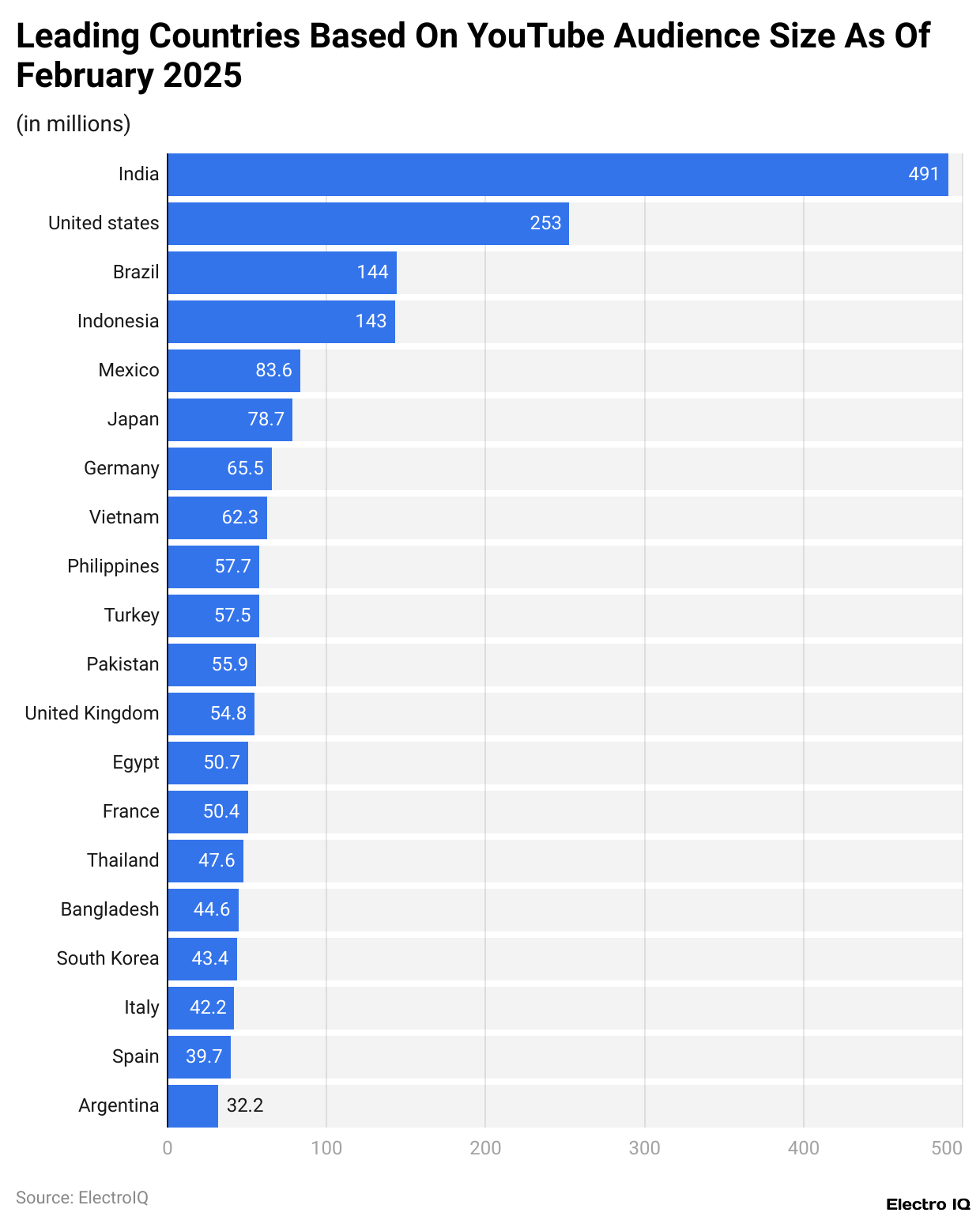
(Reference: statista.com)
Vimeo Users By Country

(Reference: enterpriseappstoday.com)
- As of February 2025, India ranked first in the world with the maximum number of YouTube users, at around 491 million.
- The state of the United States followed at 253 million users, and Brazil ranked third at 144 million users. On the other hand, the UK only had approximately 54.8 million users.
- However, in terms of penetration rate, the United Arab Emirates, in July 2024, topped the world at around 94% of its digital population actively using YouTube. This shows that, while nations like India and the U.S. dominate in total numbers, smaller countries can still top in user penetration vis-a-vis population.
- In January 2024, the app grossed around US$28 million in the US and US$19 million in Japan, thus sustaining mobile engagements and monetisation potential in those countries. YouTube also boasts nearly 100 million paying subscribers to its Music and Premium offerings in 2024, cementing its market dominance for user volume and monetisation.
- Vimeo, on the other hand, packs a much smaller but much more specialised set of users. While YouTube, in essence, is focused on mass-market engagement, Vimeo user associations indicate professional or enterprise adoption, depending on the country.
- Germany heads the Vimeo affiliations with some 130,000 users, followed by the UK with 100,000 and Brazil with 50,000. Other important ones include Australia (46,000), Netherlands (42,000), Canada (42,000), France (40,000), and Italy (32,000).
- Such a distribution is indicative of the fact that Vimeo, although not even close to the scale of YouTube, has managed to plant its feet deep into critical international markets, especially Europe.
YouTube vs. Vimeo: Reach vs. Professionalism
- According to the Vimeo blog, YouTube vs Vimeo statistics show that YouTube has perhaps the greatest reputation worldwide for being the easiest and most convenient site for sharing videos.
- More than 2 billion monthly visitors ascend the portals every hour, accessing at least one billion hours of video content every day —basically, home to all videos on the internet.
- It has, as its capital ability, an open policy to allow anyone to upload a video for free, aiming at something lucrative for many creators who want to provide content to a worldwide audience via the platform.
- YouTube is the second-most visited website in the world, trailing just behind Google, but the interesting thing about it is that it is, after Google, the world’s second-largest search engine.
- However, this vast exposure on the platform sometimes works against these creators; otherwise, it is the high-on-the-downside shadow of bad and oppressive feedback.
- Vimeo, alternatively, takes an altogether different approach. With only 260 million active users in its fold, Vimeo caters more to that swanky, tech, and spatial community.
- Almost 90% of Vimeo users pay for the service by subscribing to one of the tiered plans.
- Such a system promotes good quality content and collaboration amongst professionals like filmmakers, producers, and creative teams.
- Unlike YouTube users who can upload up to 15 minutes in a day, Vimeo non-paying users may face content upload limits, thereby maintaining the curated, niche environment.
- Hence, we have a platform where quality plays precedence over quantity and attracts clientele that lean towards a more select and productive video-sharing experience.
YouTube vs Vimeo Monitization
- To monetize their content through YouTube, the creators must become part of the YouTube Partner Program (YPP). This requires that they live in a country where YPP is offered, comply with all YouTube monetization policies, such as the Community Guidelines, Terms of Service, copyright rules, and any inactive policy strikes; these are just some of the legal conditions.
- Technically speaking, they will also need to have 2-step verification turned on, unlocked advanced features, and have linked an AdSense account.
- Once these basic requirements are met, one can qualify for monetization by either gaining 1,000 subscribers in combination with 4,000 valid public watch hours within the last 12 months or 1,000 subscribers combined with 10 million valid public Shorts views in the past 90 days.
- Meanwhile, for channel membership monetization, the requirements are even more shallow: you need 500 subscribers, three recent public videos in the last 90 days, and either 3,000 valid watch hours in the past year or 3 million Shorts views in the last 90 days.
- On the other hand, with the older Vimeo On Demand feature, the platform currently cannot offer users monetization avenues due to legal changes underway.
- Monetization, however, does exist through Vimeo OTT (now renamed to Vimeo Streaming), which offers two paid tiers: Starter and Enterprise.
- Unlike YouTube, Vimeo does not impose requirements regarding subscribers or watching hours, but requires creators to buy a monetization-enabled plan and be at least 18 years old. Vimeo’s monetization holdings focus mostly on professional and enterprise users: paywalls, subscriptions, and branded experiences, yet it lacks the open ad setup that YouTube adheres to.
- Also, every Vimeo monetizer must maintain compliance with the platform’s Terms of Service.
- In short, the system on YouTube is far more geared toward general creators with performance-based entry points, whereas Vimeo is geared toward those businesses and professionals that will pay up front for the access.
YouTube vs Vimeo Demographics
- A wider and more evenly distributed YouTube population has 25- to 34-year-olds making up the biggest share of the audience at 21.7%.
- Next, close at 18.5% are users in the 35-44 age category, followed by the 18-24 age category at 15.8%. Interest remains strong well into middle age, with 45-54-year-olds contributing 14%, and the 55-64 group at 9.9%.
- Even the 65+ seniors still form 9.5% of the entire user base, further emphasising YouTube’s reach across life stages.
- Globally, the gender makeup leans male at 54.3% and female at 45.7%, yet here in America, the platform fairs somewhat differently, showing a slightly female-majority audience(51.2% women and 48.8% men)-showing regional nuances in tuning in.
- In stark contrast, Vimeo is catering to a small yet more specialised community. In 2019, using just four months, it added close to 300,000 paying subscribers, boosting its tally from approximately 900,000 to 1.2 million.
- A third of all Vimeo users reside in the United States, with an even more concentrated presence in the West; of around two million active sites embedding Vimeo, half are U.S.-based.
- YouTube has a broad global audience that is mostly male and engages all age groups with equal strength, whereas Vimeo is a niche, U.S.-centric market that, in spite of steady growth, still sees paying clients in the minority.
Conclusion
YouTube vs Vimeo Statistics: By 2024, YouTube maintained an all-continental appeal with 2.7 billion MAUs, 49 minutes of daily engagement, and upwards of US$36 billion in revenue. Vimeo, because of its size of 300 million users, wants to shine in high-quality professional service for the creator and the enterprise. With a strategic emphasis on AI and enterprise-grade solutions, it is on track to achieve double-digit growth.
Thus, YouTube with measure and monetization, Vimeo with quality, professionalism, and niche enterprise. Both platforms offer opposed visions and need to exist mutually in the current video ecosystem—YouTube to be for universal reach and Vimeo for curated quality.
FAQ.
YouTube is anticipated to go up to US$39 billion in revenue for the year 2024, demonstrating the dominance it holds in the digital video ecosystem. In contrast, Vimeo posted US$104.5 million in Q3 2024, a reflection of its much smaller, SaaS-based business model. YouTube revenue comes mainly from advertising and subscriptions, while Vimeo largely charges paid plans for professionals and businesses.
YouTube has over 2 billion members worldwide, with over 10 billion mobile app downloads and 100 million paid subscribers through YouTube Music and Premium. Vimeo, by contrast, has about 260 million active users, with just 1.28 million self-serve subscribers and 3,800 enterprise clients as of Q3 2024. YouTube enjoys a mass-market kind of engagement, while Vimeo serves a more professional, niche audience.
On YouTube, the largest age group consists of those between 25 and 34 years old, which forms 21.7% of total users; the next largest group is the 35-44 population, making up almost 18.5%. The worldwide gender divide stands at 54.3% male and 45.7% female. Whereas, Vimeo serves a rather specialised clientele, which includes roughly one-third originating in the U.S., with about half of its embedded video content being served from websites based in the U.S., while mainly targeting creative professionals, businesses, and enterprise teams.
YouTube monetization is basically done through the YouTube Partnership Program, which requires certain subscriber and watch time thresholds (e.g. 1,000 subscribers and 4,000 watch hours in a year). Vimeo, on the other hand, engages monetization on the basis of pay-to-monetize via Vimeo OTT (Streaming), implying that creators must purchase a plan that hasmonetization enabled. Vimeo lacks an open ad-based system and instead emphasizes branded experiences, subscriptions, and paywalls for professionals and businesses.
By far, the biggest star in mobile television, with 10 billion+ Android downloads and 866 million monthly iOS users. The Vimeo app downloads have been declining, going from 7.52 million in 2021 to 2.10 million in 2023. By geography, YouTube’s top markets are India (491M) and the United States (253M), while Germany tops Vimeo at 130K downloads, followed by the United Kingdom at 100K, further attesting to Vimeo’s niche, professional-oriented focus.

Joseph D'Souza founded ElectroIQ in 2010 as a personal project to share his insights and experiences with tech gadgets. Over time, it has grown into a well-regarded tech blog, known for its in-depth technology trends, smartphone reviews and app-related statistics.


